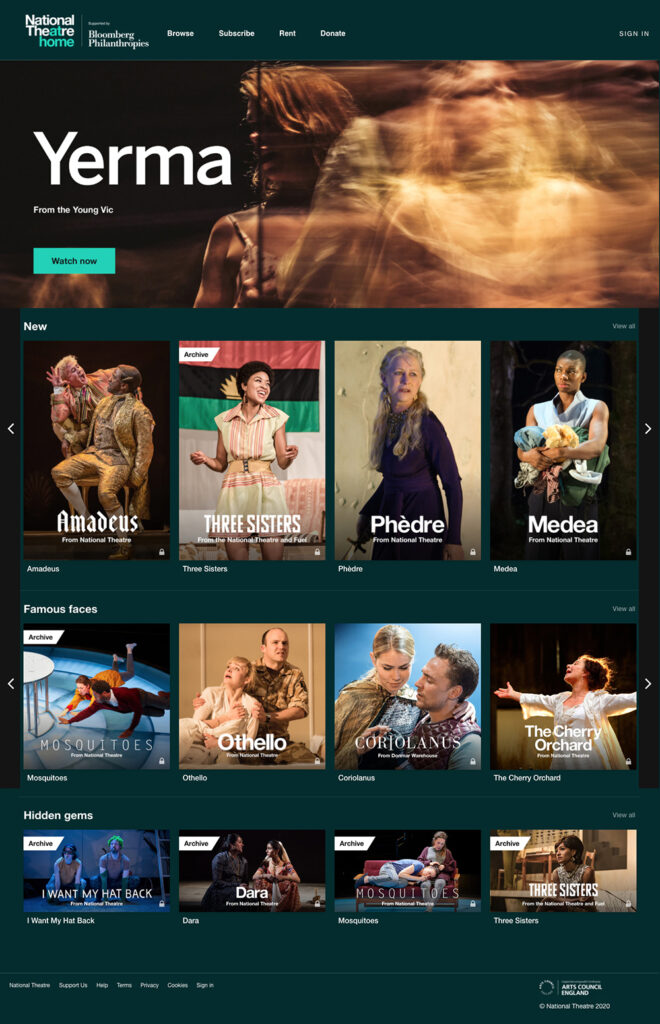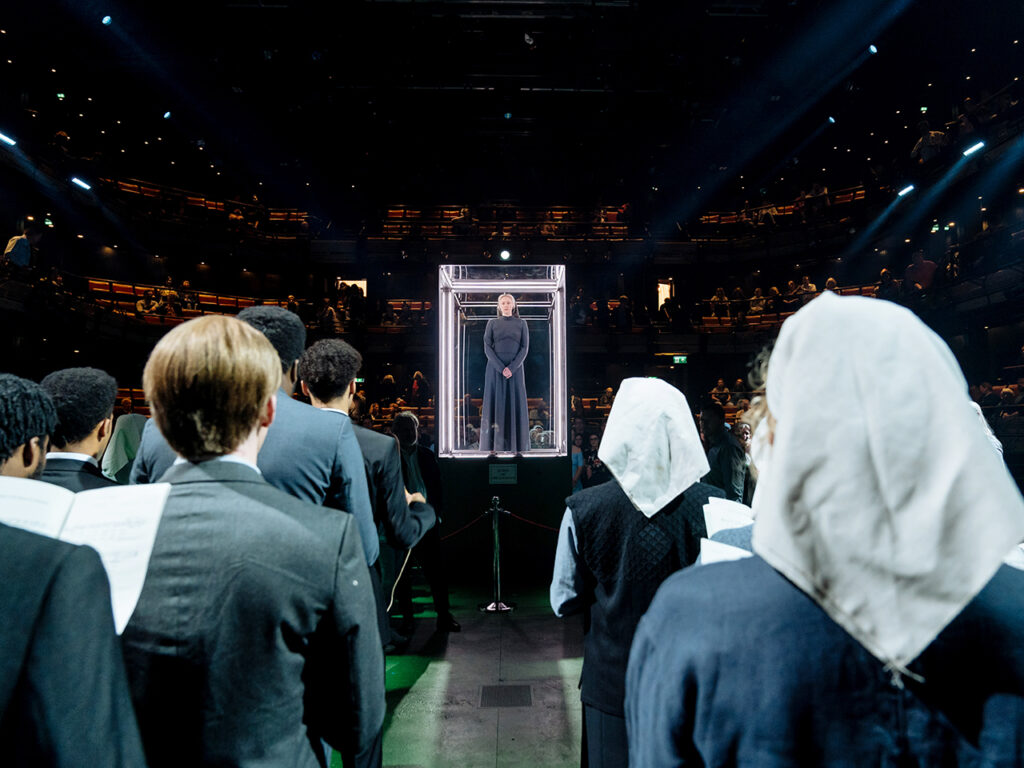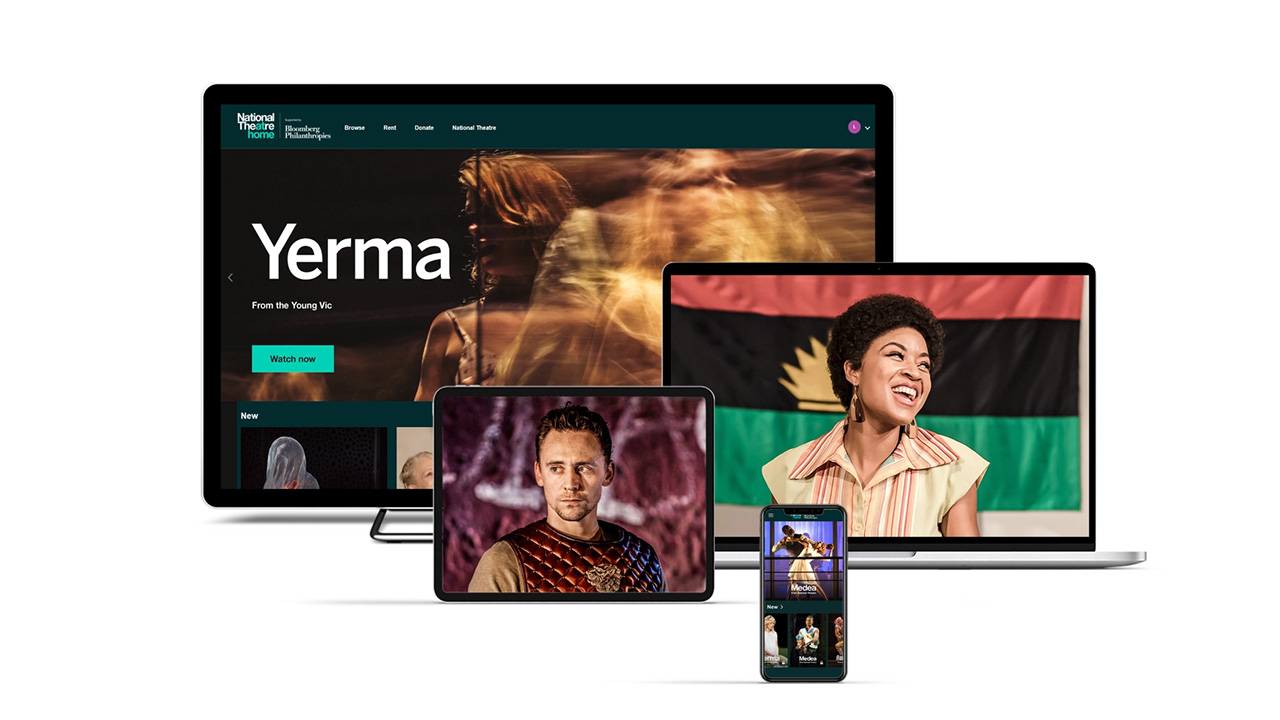In March, Vimeo announced a partnership with Tessitura Network, a long-standing customer relationship management system. And in many ways, it made sense that Vimeo OTT, the video provider’s enterprise offering that allows users to create their own branded channels with subscription and livestreaming capabilities, would find a kindred spirit in a system dedicated to connecting people to culture.
As Kathleen Barrett, Vimeo’s Senior Vice President of Enterprise and Head of Creative Success, noted on a recent episode of the Tech in the Arts podcast, “We heard a lot of desire [from enterprise clients] to have these two platforms organized together so their audience could get the most out of the experience. It was a great opportunity for us to join forces to support these organizations as they navigated new waters.”

The National Theatre at Home streaming service is accessible with a monthly subscription or pay-per-view fee. Image: National Theatre
At least one enterprise user of the OTT platform saw immediate benefits from the integration. London’s National Theatre, having launched its streaming service using Vimeo OTT in December, now had greater insight into user behaviors. On the same podcast episode, Emma Keith, the Director of Digital Media at the National Theatre, reflected, “Tessitura provides so much information and insight; we know so much about our audience members. To be able to bring our digital audience together with our in-person audience, and being able to understand our whole interaction with them is a great opportunity.”
This new digital ecosystem formed the focus of a discussion between Barrett, Keith, and Andrew Recinos, President and CEO of Tessitura Network on the Tech in the Arts’ May 24 episode. Here are three talking points on the current state of digital play and the future of digital performances.
Digital as the new normal
Last year, as lockdowns swept the the globe, Recinos was picking up on “stop-gap measures” that arts organizations were undertaking to ensure a connection with remote audiences. The National Theatre, for one, was uploading recordings of its productions to YouTube on a weekly basis to “tentatively keep ourselves going,” said Keith. With the realization that lockdown restrictions weren’t going away fast, the theater commenced development of its gated streaming platform, a more mature solution and “an extension of that in-person experience to fit in with our suite of web offerings.” (Worth noting: the venue was fortunate to already be sitting on a catalog of high-quality recordings dating back to 2009, thanks to its National Theatre Live program.)
But 2020 didn’t just hasten the digital transformations of cultural organizations; additionally, it has acclimatized audiences to the online realm. “The digital divide no longer exists,” said Recinos. “People have figured out that when done right, the digital versions of live experiences are really rich and far more convenient.” Barrett had a blunter assessment: “There’s no turning back. People that don’t adopt these digital experiences in addition to in-person experiences will be left behind.”

A 2019 performance of A Midsummer Night’s Dream at the National Theatre, photographed by Manuel Harlan
Next-level accessibility
Much has been made about digital’s accessibility, allowing organizations to vastly expand their reach and viewers greater proximity to performers. Or as Barrett deftly put it, “The whole world is your stage and your audience.” Further, as Keith pointed out, digital experiences also ensure greater access and engagement for disabled visitors. On the National Theatre’s recordings, captions and audio descriptions can be activated for those hard-of-sight or hearing. “We’re trying to break down as many barriers as possible,” she said. And while these features are available at the theatre’s physical performances, “being able to do it at the touch of a button is where digital really opens up future opportunities.”
Toward the phygital
So what’s next for digital offerings? “Refinement and evolution,” said Keith; considerations about “how to make them richer,” added Barrett. These enhancements, all participants concurred, should stem from live, physical experiences. According to Barrett, the question then becomes, “How do we build technology to replicate [in-person experiences] even further and make it feel like there’s a feedback loop?”
This is where interactive features such as live chats and comments sections come in, offering digital viewers a collective and social experience, or what Keith termed the “interval moment.” For now, it’s hardly a perfect replication of the theatergoing experience (who chats during a performance?), but the creation of such “moments,” for her, remains key to future digital engagement. It’s about generating “a sense of an event about it,” she said, “and how we can keep that going in the digital sphere.”



